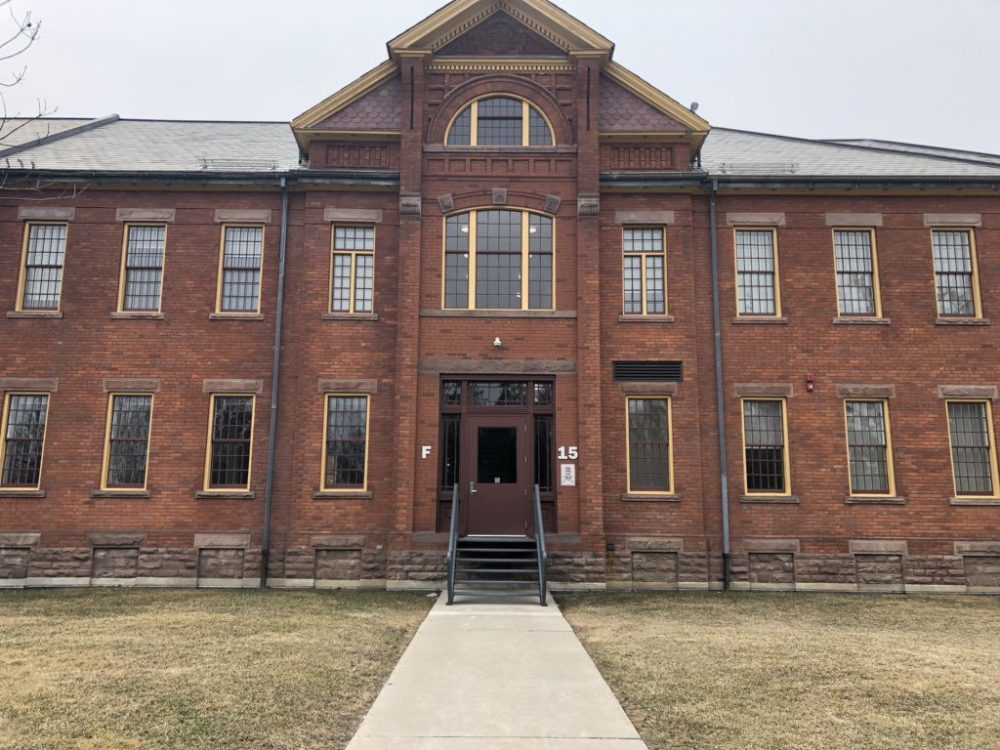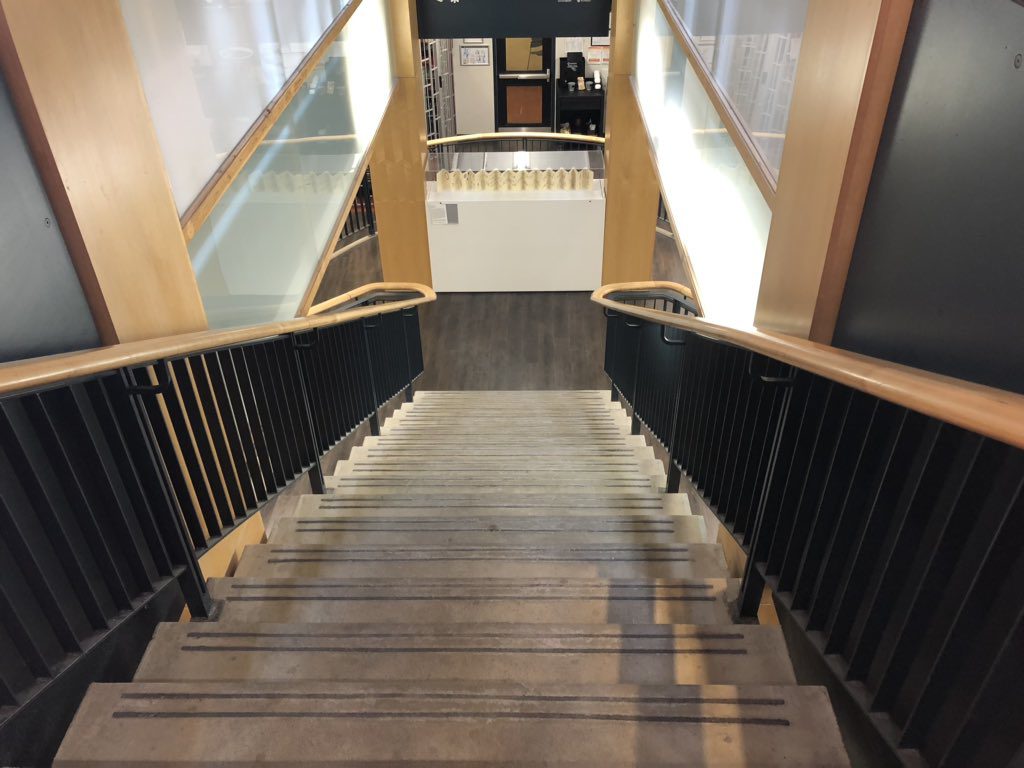[vc_row][vc_column][vc_column_text]
[/vc_column_text][vc_column_text]
Torontonians may know some of Etobicoke’s history, but many may not know about the riveting past of the Humber College Lakeshore Campus and it’s prior occupant, the Lakeshore Psychiatric Hospital.
By Vanessa Rogers
“The first time I went to the G-building, we got out of the elevator … and there were two handprints on the door perfectly aligned as if they were holding onto the door to look out.”
Ivy-Lynne Halis tells herself she’s not going to freak out about something “so stupid”.
Halis is a second-year finance student at Humber College’s Lakeshore Campus. She has had some creepy experiences associated with the grounds. Including this experience on October 3rd, 2017.
After they exit the elevator, Halis and her boyfriend go outside for a cigarette. Shortly after, about half an hour later around 2 p.m., they go back to the second floor of the G-building. The steel elevator door closes, and she looks to where the handprints once were and realizes they are now gone.
Just before she saw the handprints, Halis was sharing a story to her boyfriend that she heard about a ghost. A story about an old nurse who was unable to be with a patient whom she fell in love with and now wanders around the campus and haunts the buildings.
Before students roamed the halls of the Humber College Lakeshore Campus, the buildings were once home to patients of a mental hospital.
Due to its history and the idea of an asylum, the campus grounds and its tunnels have become the birthplace for countless ghost stories and lore. Although many people believe it isn’t haunted, some are certain that it is.
History of the grounds
[/vc_column_text][vc_raw_html]JTNDaWZyYW1lJTIwZnJhbWVib3JkZXIlM0QlMjIwJTIyJTIwY2xhc3MlM0QlMjJqdXh0YXBvc2UlMjIlMjB3aWR0aCUzRCUyMjEwMCUyNSUyMiUyMGhlaWdodCUzRCUyMjQ5MCUyMiUyMHNyYyUzRCUyMmh0dHBzJTNBJTJGJTJGY2RuLmtuaWdodGxhYi5jb20lMkZsaWJzJTJGanV4dGFwb3NlJTJGbGF0ZXN0JTJGZW1iZWQlMkZpbmRleC5odG1sJTNGdWlkJTNEOTUzMTIxYWEtNGMxOC0xMWU5LTgxMDYtMGVkYWY4ZjgxZTI3JTIyJTNFJTNDJTJGaWZyYW1lJTNF[/vc_raw_html][/vc_column][/vc_row][vc_row][vc_column][vc_column_text]
Located along the shores of Lake Ontario, at Kipling and Lake Shore Blvd. W in the west of Toronto, Mimico Asylum was the first inhabitant of this 60-acre land in the late 1890s.
The institution was built as a branch of the Toronto Asylum for the Insane when it became overcrowded with patients. It officially opened as the Mimico Branch Asylum on January 21, 1889.
During the construction of the buildings, the workers and some patients were digging to build the foundation, when they struck a gas well. They capped it and used it for heating the buildings. This gas ran for many years and allowed the buildings to heat themselves at no cost to the hospital.
The asylum was home to patients who were considered incurable. Patients would perform labour tasks, working construction, cleaning, farming and other forms of labour without pay until the late 1950s. This work was deemed therapeutic for patients and gave them the opportunity to learn skills and fill their time in productive ways.
Early on, the hospital wasn’t given much money to buy food for the patients, so they had to grow their own. The patients were successful farmers, they grew an abundance of food. The patients grew so much food that it was consequently sold back into the prison system.
Name changes and closure
In 1894, the asylum became an independent institution due to an increasing number of patients. It was then renamed the Mimico Asylum.
It became the Mimico Hospital for the Insane in 1911. In 1920, it changed to the Ontario Hospital, until finally settling on the Lakeshore Psychiatric Hospital in 1964. This remained the facility’s name until its closure in 1979.
The name changes over the years signify the changing attitudes towards mental health patients and the facilities that housed them.
After large scale-Victorian asylums were seen as inhumane and repair costs started to add up, the asylum closed in 1979.
The land was then rented out to produce films and still is used for this purpose occasionally to this day. Films from Police Academy (1984) to Suicide Squad (2016) were shot on the grounds.
In 1991, Humber College bought out a 99-year lease and began renovating the buildings to make them into classrooms.
A pretty interesting place
Due to its history, many have speculated that certain parts of the Humber College Lakeshore Campus are haunted.
Those who are familiar with the campus don’t think it’s haunted, others swear it is.
Linda Roberts has seen the changes from the Lakeshore Psychiatric Hospital to Humber College first-hand. When she was a child, her mother was a patient at the hospital.
She prefers to remember the grounds as being very peaceful and beautiful.
“I have a bit of a history there because my mother was a patient in the 70’s at that particular hospital and we used to go visit her,” Roberts said. “We would sit outside on the grounds and it was always peaceful and nice. It’s a lot busier now obviously, but it’s a nice spot in the city … It’s a pretty interesting place.”
She now lives down the street from the campus and walks her dogs there.
Roberts says for all the years she has lived there and visited the hospital, she hasn’t heard or seen anything paranormal.
Listen to Linda’s full story here.
Present day
Down a hallway in the basement of the F-Building, there is a door with green tape holding down a sign, “tunnel access” in all capitals.
Behind the door, white paint is chipping off the walls to show the grey concrete underneath. At the end of the hallway, arrows and the letters “E” and a backwards “G” are spray-painted, pointing to either side of the darkened path.
These tunnels were used by the Lakeshore Psychiatric Hospital to get to the different patient cottages and are now used for servicing, janitorial purposes and historic tours by the college.
Halis uses the tunnels sometimes to get to different buildings throughout the campus faster.
She says that she has heard “weird ticking noises” when she went down there and that overall, it’s a chilling atmosphere.
“It’s one long hallway, and when you’re walking down right as you get near one of the entrances of the buildings, there will be a separate hallway … then there’s another door,” Halis says. “The door looks like when you’re in the basement of a hospital and it’s cold and dark and the lights are always flickering.”
[/vc_column_text][/vc_column][/vc_row][vc_row][vc_column][vc_single_image image=”13213″ img_size=”large” add_caption=”yes” css=”.vc_custom_1555518147666{border-radius: 35px !important;}”][/vc_column][/vc_row][vc_row][vc_column][vc_column_text]
Outside, the campus grounds are very quiet. Not eerily so; the word peaceful comes to mind. Only the sounds of birds chirping, wind blowing, and the occasional passing of other people and distant cars are heard.
You can see the history in the buildings when you look at them from the outside. Each of them have red mismatched brick with a large grey letter from C to K on the left of their wood doors. Paired with yellow painted window sills, it seems like each building was plucked right out of the 1950s.
They might as well have been, as minimal changes have been made to the buildings’ exterior. The buildings aren’t allowed to be removed or demolished due to it being considered a designated heritage property in 1988.
It all depends on what you believe
Steve Bang is a professor of business at Humber College and one of the guides to the tunnel tours.
“I have to say that I think it’s a hoax,” Bang said. “When they closed the hospital in 1979 … there was a number of squatters that actually moved into the buildings and lived in the attics … I think what happened was that people wanted others to stay away because they were living in the buildings so they created a hoax that would give the people a feeling that there might be some sort of ghost.”
[/vc_column_text][/vc_column][/vc_row][vc_row][vc_column]
[/vc_column][/vc_row][vc_row][/vc_row][vc_column][/vc_column][vc_column_text]I think it’s a hoax.
Bang has worked at Humber for 19 years now and says he hasn’t experienced anything abnormal.
“I’ve been everywhere in the campus,” He said. “Never once have I ever seen anything that you could say was out of the ordinary.”
However, he doesn’t deny the rich history and the interesting stories of all the people who lived and worked at the psychiatric hospital.
“There’s no doubt that a lot of people died there, if you read the history it’ll tell you that people died. This was a permanent facility. Most cases, when you went in you never came out.”
However, there are multiple accounts and stories from students, workers and the public who said they have experienced something paranormal in these buildings.
“It all depends on what you believe.”
[/vc_column_text]






